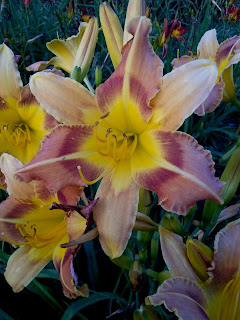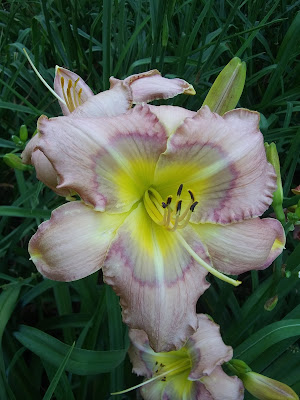Sun Dragon Daylilies
Foundational Tetraploid Introductions
Or...
'An Ode To Stout'
In developing my own tetraploid lines I began by crossing modern, hybrid, flower-selected tetraploid cultivars (which originated through induced conversion to create the hybrid tetraploid gene pool that we commonly encounter) with triploid species clones or near-species triploid and/or tetraploid cultivars. That work is detailed in the articles ‘Tetraploid Program Overview’ and ‘The Four Bases’.
The results from the first generation of such crosses form what I consider to be the basis of my program, and all cultivars coming into my gene pool have to filter through one of the four bases, either directly or through one of these first generation seedling plants (and some of these have become introductions). In the early years of my program, of course, all of the hybrid cultivars I was working with were being crossed to one of the four bases. Once I began to have a good number of select first generation seedlings, then any hybrid cultivars brought in began to go across these F1 seedlings more often than onto one of the four bases. At this point in my program I am using these F1 and later plants almost exclusively, and rarely go back to one of the four bases, but I still maintain them all and can go back to them if needed. At this point it would be a step backward for my purposes.
The results of the four bases crossed with fancy, hybrid cultivars is intermediate to the two parents, with species genetics showing marked dominance, though fancy, modern phenotypes can often be clearly seen, even in the F1. A good example is contrast edges, pie crust/braid edging and eye/edge. Just as I expected when I began the program, the flowers of the F1 have a species look about them, and they tend to superficially resemble the styles of flowers that Dr. Stout produced in some of his later-generation hybrids - cultivars such as Linda or Challenger, for example. Having been aware of Dr. Stout since I was a child voraciously devouring all things daylilies, superficially reproducing his work at the tetraploid level has been interesting and informative.
However, the resemblance to Dr. Stout’s introductions is superficial, as there are some very distinct differences in his work and mine. Ploidy, obviously, is one major difference. Stout produced no tetraploids, lacking any converted material, and for whatever reason, to my knowledge, didn't attempt to produce tetraploid seedlings from the triploid species materials he grew. I am working with triploid species clones (fulva clones or varieties, specifically the Korean form and 'Europa' through the cultivar 'Implausibility', an F1 seedling from Europa) and converted tetraploid hybrid cultivars. In the hybrid tetraploid cultivars, I have focused on Ancient Elf and Notify Ground Crew, both deriving from converted materials of exceptional plants of great vigor and size with species-like phenotype, which are not very closely related to the standard tetraploid gene pool. With the fancy hybrid cultivars from other hybridizers, I selected for both great flowers and good plant performance in my environment. While some Stout cultivars have been converted through the years, he produced no tets, while that is the main focus of my program.
Beyond that, an even bigger difference between my program and that of Dr. Stout is that while some of our introductions may bear some resemblance, his were all made from the blending of various species, with no access to an advanced hybrid gene pool to draw from and gather advanced genetic combination from. Mine, on the other hand, from the very first outcrosses, all incorporated advanced modern genetics from many advanced hybrid tetraploid daylily breeding programs. By using the advanced plants from the beginning, that puts my F1 plants many years ahead of the Stout introductions, genetically speaking, giving them a big head start on the wonderful plants Stout produced in terms of the genes they carry and their breeding ability. My program is based on Stout's, and for what I wanted to do, there was no way to not have the first generation plants resemble his program. In fact, it was a goal, because it charts ground that has not formerly been charted in the tetraploids, bringing in new genetic diversity from the species and near-species plants.
My introductions that appear similar to some of Stout's introductions represent the first generation of my breeding, while their counterparts in Stout's program represent multiple generations of breeding within his program. One of the main things that has stood out to me as very interesting and useful is that by taking species and near-species conversions to a fancy-flowered modern hybrid creates F1 seedlings that are generations beyond where Stout was working, genetically speaking. Those F1 seedlings I have produced can in turn produce seedlings much more advanced when bred back to fancy cultivars of known plant strength, again representing another jump of multiple generations of breeding in terms of phenotype advancement. It took the original hybridizers multiple generations of breeding to go from the phenotypes that I see in my F1 and F2. When I look at the F1 and F2 I have produced when crossing the F1 back to modern fancy flowers, I see the F1 looking superficially similar to Stout's later introductions (1940s - 1960s), while in my F2 seedlings, in many instances, compare favorably to cultivars from the 1980s through the early 2000s.
I certainly never expected two generations to make my seedlings comparable to other programs where the focus has been solely on flower advancements, but in the third generation, where I am blending my own select F2 seedlings, I see flowers as advanced as any of their fancy ancestors, and in some instances more advanced, or with unique combinations I didn't see in the ancestors. Many of the F3 seedlings also show the improved strength, vigor and robust form with big plants and tall scapes, with good increase and high fertility - all traits I have been consistently selecting for from the species and near-species ancestors.
What this means is that my tetraploid base plant introductions often breed quite differently than the old Stout diploids. I have used many of Stouts diploids in breeding, and even when crossing them to advanced, modern diploids, you usually don’t see as much flower advancement in the seedlings as can be seen amongst the seedlings of many of my first-generation introductions. Because the introductions at this level of my program often have a fancy, modern parent, they can throw a percentage of seedlings with far more advanced flowers than one might assume possible based on knowing there is a species/near-species parent or by looking at the flower and just assuming "looks like a Stout, so would breed like a Stout".
Most of my F1 tetraploid introductions at this level of my program have been actively selected for a range of plant traits, including rust resistance, along with an emphasis on reduced thrips susceptibility. While many of Stout’s cultivars show some level of rust resistance, this owe to chance and not selection, and is retained from some of the original species clones carrying rust resistance due to their evolutionary history in Asia in conjunction with daylily rust. By chance, many clones of H. citrina and H. fulva show good rust resistance, and by chance, Dr. Stout used both a lot. Both are also heavily represented in my work. That is because I like them, but also because they gave their descendants that I was working with useable rust resistance levels, as well as breeding value for the trait. As the vast majority of my introductions at this level were bred in the very beginning of my program, many of them will have gone through all five years of rust resistance selection and breeding value observation. Of the four bases, H. Fulva ‘Korean’ and Ancient Elf show the greatest rust resistance and breeding value of any daylilies I have worked with. Notify Ground Crew and Implausibility both show good rust resistance (though just lower then AE and HFK) and moderately high breeding value for rust resistance (just lower than AE and HFK). In terms of thrips resistance, Notify Ground Crew shows the best of the four with the other four showing fairly high susceptibility to thrips. Luckily (by randomness, chance, fate or whatever), the hybrid cultivar Solaris Symmetry (one of my Secondary Level cultivars) shows very good resistance to thrips and a small number of its seedlings with the four bases came out with much improved thrips resistance, with the introduction Sun Dragon (Ancient Elf x Solaris Symmetry) showing the highest thrips resistance of all my base level introductions.
Finally, under examination, you will note many characteristics in my introductions that are not present in any of the early Stout introductions. Because we become so accustomed to seeing traits like double edges, eye patterns or colors that are high modified from wild type, in very advanced combinations, we may not immediately recognize such traits when we see them as heterozygotes in species-like backgrounds, and thus overlook them. Yet, such traits are not present in any of the early Stout cultivars because they had not been brought into refinement through selection in his time. Because I used advanced flowers such as Solaris Symmetry, Queen’s Circle and Bali Watercolor, to name a few, some of these fancy traits are expressing in my first generation seedlings, but not in the same way they did in their fancy, modern parent, making their colors, forms or patterns superficially resemble some of Stout's introductions. Two excellent examples are Sun Dragon and Korean Queen. We have looked at some photos ofSun Dragon and some of its descendants above. We will look at Korean Queen and some of its descendants below.
Before we move on to the images, I want to mention that I have nineteen introductions to date (2024) that are selected F1 tetraploid base plants (Species/Species-like Base Plant x Fancy Tetraploid Cultivar). These are the basis of my breeding program, representing the plant style that I want, and carrying the genetics to produce the flowers that I want to work with as my program advances.
Nineteen selected F1 tetraploid base plant Introductions:
Sun Dragon, Korean Queen, The Spice Must Flow, Eos At Dawn, Spice Addiction, Far Above The World, Origin Of Symmetry, Ancient Ent, Implausibly Ancient, Ancient Solar Flare, Elven Sunburst, Implausible Titan, Elizabethan Ruby Ring, Elizabethan Lips, Wookie Goddess, Dracarys, Temple Of Bacchus, Korean Mother Of Pink and Korean Mother Of Purple.
________________________









%2020230627_193010%20((AE%20X%20BALIWAT)%20X%20COOLER%20THAN%20ME)%20X%20SUN%20DRAGON))%20X%20(ASTRAEA%20X%20SUN%20DRAGON))%2011.jpg)











